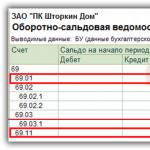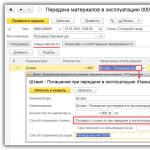To automatically generate RSV-1 in 1C 8.2, you must perform the following steps:
- In the Reports → section you need to select Regulated reports;
- By function<Добавить элемент списка>– the RSV-1 PFR form is selected;
- Period – the reporting period is set;
- Next click<Ок>;
- When you press<Заполнить>– the RSV-1 report will be generated automatically in 1C 8.2;
- After this, you need to check the completion of the report and, if necessary, make adjustments to it.
In order to create the printed form RSV-1 in 1C 8.2 Accounting, you need to perform the following steps:
- There is a button at the bottom of the form<Печать>;
- If you select Show form, the print service will open. Then you can print all the sheets in the report, or only those that are checked;
- Print via<Печать>.
How to check the correctness of filling out a report to the Pension Fund of the Russian Federation according to the RSV-1 form in the 1C 8.2 Accounting program is discussed in the form of step-by-step instructions.
Instructions for filling out the RSV-1 form in the Pension Fund of Russia
Step 1. Filling out the title page
At the first step, information indicators about the taxpayer and the reporting period are generated. A sample title page of the RSV-1 form is presented below:
Step 2. Completing Section 2
In the second section of the RSV-1 form, the calculation established for the taxpayer is made.
Filling out the section on compulsory pension insurance
In the line Base for calculating insurance contributions for compulsory pension insurance (lines 240 and 241), the base is calculated by age:
- For workers 1966 and older according to the formula (page 201+ page 203 – lines 211 -213 -221 -223 -231 -233)
- Let’s say, for example: 80,539.21 + 0 – 0 – 0 – 0 – 0 – 0 – 0 = 80,539.21 rubles. – page 240;
- For persons born in 1967 and younger according to the formula (page 202 – lines 212 – 222 -232)
- Let’s say, for example: 321,295.54– 3,195.63 (sick leave benefit) – 0 – 0 = 318,099.91 rubles. – page 241;
In the line Accrued insurance contributions for compulsory pension insurance, contributions are calculated: insurance and savings part (line 250, line 251), if their amount is more than the maximum value of the base (line 252) according to the formula: Amount of contributions = Base for contributions * Tariff for contributions.
- So, in our case, the calculation of contributions for the insurance part: 80,539.21 * 22% + 318,099.91 * 16% = 68,614.62 rubles.
- The calculation of contributions for the funded part was: 318,099.91 * 6% = 19,086.00 rubles.
Filling out the section on compulsory health insurance
In the line Amount of payments and remunerations in favor of individuals (p. 271) - the amount of payments is written down by month in the reporting period (columns 4-6) and in total on an accrual basis (column 3). Filling is similar to the indicators of the lines on the OPS (lines 201 + 202 + 203 are summed up).
In the line Base for calculating insurance premiums for compulsory medical insurance (p. 275), the base is calculated using the formula (p. 271 - lines 272 – 273 – 274).
- In our case: 401,834.75 – 3,195.63 – 0 – 0 = 398,639.12 rubles – p. 275;
In the line Accrued insurance premiums for compulsory health insurance, contributions to the FFOMS are calculated using the formula: Amount of contributions = Base for contributions * Tariff for contributions.
- Checking the calculation of contributions to the Federal Compulsory Medical Insurance Fund: 398,639.12 * 5.1% = 20,330.60.
You can also check the amounts of contributions with the balance sheet for the credit turnover of accounts 69.03.01 “Federal Compulsory Medical Insurance Fund”. Similarly, you can check calculations for all columns by month of the period:

Example of filling out Section 2 of RSV-1:

Step 3. Completing Section 1
In the first section of the RSV-1 form, the accrued and paid contributions for compulsory pension and health insurance are calculated, and the balance for them is also indicated.
In the line Accrued insurance premiums from the beginning of the reporting period (p. 110) – the total amount of accrued premiums on a cumulative basis from January 1. The data in the line must match:
- amounts from section 2 column 3:
- contributions for compulsory medical insurance – page 276;
- the sum of the data from section 1 page 110 of the calculation of the previous period and the data from section 1 page 114 of the calculation of the reporting period.
In lines 111, 112, 113 – the amounts of contributions accrued for the three previous months are entered. The data in the lines must correspond to the data from section 2, columns 4, 5, 6:
- insurance part – p.250 + p.252;
- accumulative part - p. 251;
- contributions for compulsory medical insurance – page 276;
Line 114 reflects the amount of insurance premiums for the last three months of the reporting period, which is determined by the formula (lines 111 + 112 + 113).
In line 130 - the total amount of insurance premiums payable, which is determined by summing lines 100+110+120.
In line 140 - you need to indicate the amount of contributions paid on an accrual basis from January 1 to the reporting date. The data in the line must correspond to:
- debit turnover on accounts 69.02.1, 69.02.1, 69.03.1 in correspondence with account 51;
- the sum of the data from section 1 page 140 of the calculation of the previous period and the data from section 1 page 144 of the calculation of the reporting period;
In lines 141, 142, 143 - you need to enter the amount of contributions paid for the last three months. The data in the lines must correspond to the amounts of monthly contributions (debit turnover on accounts 69.02.1, 69.02.1, 69.03.1);
Line 144 reflects the summation of lines 141 + 142 +143.
Sample of filling out RSV-1 Section 1:

Drawing up a payment order for payment of contributions to the Pension Fund
The procedure for filling out the fields of the payment order when paying monthly insurance premiums to the Pension Fund of the Russian Federation (insurance part):

KBK for payment of contributions to the Pension Fund
In field 104 “KBK” you need to enter the budget classification code for the contribution being paid.
Attention! BCC is an important detail; if it is indicated incorrectly, the insurance premium will not be credited correctly and will entail the accrual of penalties.
In our example, the following BCCs are indicated:

Details for payment of insurance contributions must be found in your pension fund or on the official website of the pension fund. For Moscow, you can use the website www.pfrf.ru/ot_moscow.
Example of a payment order for the payment of insurance premiums to the Pension Fund (insurance part)
To automatically generate a payment order in 1C 8.2, you can use the Generation of payment orders for taxes payment processing through the Bank menu:

Full list of our offers:
The closer the end of July is, the more different questions regarding reporting arise from our clients. And here is one of the latest hits in the list of various problems: after submitting the calculation of insurance premiums, it turned out that one of the employees changed her last name, but “forgot” to warn the HR department about this, and as a result, the tax office asks to send an adjustment calculation with clarification for this one employee .
Summer is the time for weddings, and this question has turned out to be one of the most pressing over the past two weeks. Today I will talk about a wonderful opportunity of the 1C program: Salaries and personnel management 8, ed. 3 automatically analyze the changes that have occurred in the program compared to the submitted report and generate an adjusting DAM.
So, the accountant generated and sent a calculation of insurance premiums for the first half of the year. By the way, a little off topic. In 1C: ZUP 8, ed. 3, a very convenient opportunity has appeared to create a register of amounts for employees included in section 3:

Using this magic button, we get this detailed report with the base for calculating insurance premiums for each employee for each month:

This kind of “usefulness” recently appeared in the program.
So, let's return to the unsuspecting accountant, who, having received the report submission protocol, was incredibly surprised that one of the employees was happily married and changed her last name.
First of all, we need to open an individual’s card and change the employee’s last name. To do this, we will use a special form Change of name:

The history of name changes can be viewed in a special form:

Well, in fact, we are all ready to fill out the adjustment DAM. We create a new report in the form Calculation of insurance premiums (read where to find the report in the program. On the title page, set the adjustment number and click on the Fill button. The program will automatically compare the current data with the information in the submitted report, and then fill out section 1 with the same data as in the first report taking into account all changes, and section 3 will include only those persons for whom there are changes compared to the previous report.
Until November 15, 2013, insurance companies must provide the Pension Fund of Russia with individual information about insurance premiums accrued and paid, as well as information about the insurance period for each employee working in it (including employees working under GPC contracts).
Let's consider how to reflect operations for the preparation of personalized information about employees, as well as the formation of regulated reporting to the Pension Fund of the Russian Federation.
An example of the sequence of actions will be built on the basis of a new platform released by 1C, "1C:Enterprise 8.3" in "Taxi" mode. This platform will soon be the main version supplied by 1C, so in all subsequent articles only it will be used for examples.
Filling out initial information
To correctly fill out data on the insurance and funded part of the labor pension in regulatory documents, it is necessary to enter personal information about the company’s employees and reflect the calculation of wages.
To hire an employee, you need to add a new “Hiring” document. This document is located in the “Employees and Salary” section
When you press a button<Создать>The “Employment” document form will open, in which you must fill in the required details.

In the “Employees” directory, you need to add a new card and fill in personal data that will be used when filling out regulated reporting.


Payroll for employees
After generating basic data for employees, it is necessary to generate payroll documents. For this purpose, the system contains the document “Payroll”, which is located in the “Employees and Salaries” section.

In the “Employees and Salary” section, you need to switch to the “Payroll” document journal and add a new document.

In the added document, you must indicate the period for calculating salaries, the dates of accrual and click the button<Заполнить>. By clicking on this button, all tabular parts of the document will be automatically filled in - Deductions, Personal Income Tax, Contributions.
The “Accruals” tab will display information about the employee’s accruals; all information about deductions can be obtained on the “Deductions” tab.
The amount of personal income tax withheld must be checked on the “Personal Tax” tab

The “Contributions” tab displays data on accrued contributions to the Social Insurance Fund and the Pension Fund of the Russian Federation.

When posting a document, the program will generate a group of transactions for payroll, withholding personal income tax amounts, as well as deductions to funds.

Generating data for personalized accounting
After completing documents for calculating salaries and generating accounting entries for contributions to funds, it is necessary to fill out documents for personalized accounting (SZV-6-4, ADV-6-2, RSV-1).
To do this, in the “Employees and Salaries” section, click on the button<Еще>and select “Quarterly reporting to the Pension Fund” from the list.

In the form that opens, click on the button<Создать комплект за 3 кв. 2013 г.>. If a package of documents is being created for the first time, this button will be active, but if a package of documents has already been created and transferred earlier, then it will only be possible to correct it. To do this you need to use the button<Создать корректирующую форму РСВ-1>.
When you click the button, an assistant form will open, in which all employee data available in the system will be automatically filled in. Documents will be created:
- SZV-6-4
- ADV-6-2
- RSV-1
If payments were made to the tax authorities during the process of accruing debt to the tax authorities, this data will automatically be reflected at the bottom of the assistant form

If, when checking data, errors occur in filling out personalized reporting, the program will highlight the erroneous data in red and mark it with a special icon with a question mark.

After correcting these errors, the program will automatically generate data upload files for transmission to the tax authorities.
By button<Печать>printed forms of the entire package of reporting documents will be automatically generated


Best wishes,
ArkNet company team
The full version of the article can be downloaded in the format or
All companies with at least one employee on staff are required to submit insurance premium calculations to the Federal Tax Service. This information is necessary to track the number and income level of employees. Many people have difficulty generating this report, so we have prepared practical material on the features of creating calculations for insurance premiums in the 1C: ZUP 8.3.1 program.
StageI. Preparatory
Employee income accruals are the basis for generating the “Calculation of Insurance Premiums” report. An employee's income may include the following accruals:
- wage;
- monthly bonuses;
- quarterly;
- annual;
- temporary disability benefits;
- vacation pay;
- and so on.
In order to correctly reflect and generate insurance premiums in the program, you should make the appropriate tariff settings (section Salary → See also → Types of insurance premium tariffs). Rice. 1.
The calculation of the base for calculating insurance premiums is the document “Calculation of salaries and contributions” (section Salary → Calculation of salaries and contributions). Rice. 2.

Click on the “Create” button to create a document and indicate the period for calculating salaries and contributions. Then click the “Fill” button to reflect the employees for whom “Salaries and contributions are calculated.” To obtain information about the base for calculating insurance premiums, you can use the “Analysis of contributions to funds” report (section Taxes and contributions → Reports on taxes and contributions → Analysis of contributions to funds). Rice. 3.

The generated salary accruals and insurance premiums are reflected in the document “Reflection of salaries in accounting.” It displays accrued income and insurance premiums for each employee for the month of accrual.
To correctly reflect insurance premiums in the “Calculation of Insurance Premiums” report, you must correctly indicate the status of the insured person (section Personnel → Employees → Insurance link or in the “Individuals” directory). In the personal card of an employee or individual, you must indicate the date of change of status.
StageII. Generating a report
After we performed in the program “1C: ZUP 8.3.1.” After all the necessary settings and charges, you need to proceed to generating the “Calculation of insurance premiums” report. It is filled out in the section Reporting → Certificates-1C reporting. Click the “Create” button to select the “Calculation of insurance premiums” report and indicate the period for generating the report. The document consists of a title page and sections for reflecting information on the calculation of insurance premiums. Section 1 contains data on the obligations of insurance premium payers. It is filled out according to the ten Appendices that relate to it. This section should reflect the total data on insurance premiums required for payment to the budget. More detailed data on the assignment of contributions is provided in the appendices to this section.
Section 2 “Calculations for insurance premiums” is intended for peasant (farm) farms (peasant farms). Section 3 contains personalized information about individuals, that is, a list of personal data about individuals. So, in addition to the full name and SNILS, the TIN, date of birth, citizenship of the employee, information about the employee’s identity document are provided. The data in this section is compiled based on the results of the last three months of the reporting year.
Cases when section 3 of the report “Calculation of insurance premiums” is completed:
- If payments are made to employees under employment or civil law contracts.
- When an employee is on leave without pay.
- When an employee goes on maternity leave, in the calculation of insurance premiums in Section 3 for an employee on maternity leave, a report is generated without filling out subsection 3.2 on payments.
- If the organization has only one employee, including the director, who is the founder.
- If in the accounting quarter accruals and payments were made for dismissed employees.
The title page, Section 1, Subsections 1.1 and 1.2, Appendix 1, Appendix 2 and Section 3 are made up of all organizations and individual entrepreneurs, payers of insurance premiums, making payments to individuals. Rice. 4.

The remaining sections and applications are formed as necessary, if there is information to fill out.
In the program "1C: ZUP 8.3.1." The “Calculation of insurance premiums” report is generated automatically, subject to the conditions for the correct and timely formation of salaries in the program.
To correctly generate the “Calculation of Insurance Premiums” report, you need to update the program to the current version. Since January 2017, the Federal Tax Service Inspectorate has introduced new conditions for accepting reports: personal data of individuals must completely match the data in the Federal Tax Service Inspectorate database. If the data on employees does not match the data in the Federal Tax Service Inspectorate database, the report will not be accepted by the Federal Tax Service Inspectorate.
In this article, we have highlighted the main points that you should pay attention to when generating the “Calculation of insurance premiums” report. To summarize, I would like to note that correct accounting of the accrual and payment of wages and other charges is an advantage for the correct formation of this document. We wish you successful completion of your annual reporting!
Dear readers, submit your reports without any problems! Our consultants have extensive experience in 1C programs and are ready to help you with the generation of any report. Book a consultation.
Work in 1C with pleasure!
“1C: Salary and Personnel Management” (hereinafter we will use the short name 1C 8.3 ZUP) allows you to prepare and automatically generate a form for calculating accrued and paid insurance contributions for compulsory pension insurance in the Pension Fund of the Russian Federation and for compulsory medical insurance in the Compulsory Medical Insurance Fund by insurance premium payers making payments and other remuneration to individuals (form RSV-1 or RSV report in 1C). You can learn how to do this in this article.
To form RSV-1, it is necessary to correctly perform a clearly defined sequence of actions. The process of generating the RSV-1 report in 1C 8.3 ZUP can be roughly divided into three steps:
- Prepare information for the RSV-1 report in 1C 8.3 ZUP: complete the settings and enter the necessary data;
- Generate the RSV-1 report in 1C 8.3 ZUP in automatic mode;
- Submit a report to the Pension Fund.
And now a little more detail about each of these steps:
Step 1: Prepare information for the RSV-1 report in 1C 8.3 ZUP
In order for the RSV-1 report to be correctly generated, correct information must be entered in 1C 8.3 ZUP. The source of information for the formation of RSV-1 in 1C8.3 ZUP is:
- Information about the organization: you must correctly indicate the full name of the organization, INN, KPP, registration data of the Pension Fund of the Russian Federation and the Social Insurance Fund, full name of the head of the organization, OKVED codes. Information is entered in the "Organizations" directory: section "Settings", group "Organization", command "Organization details" (if only one organization is kept in the information base) or "Organizations" (if several organizations are kept in the information base) ;
- Territorial conditions of an organization or a separate division of an organization. If the organization is located in special territorial conditions (for example, in the area of the extreme server or equivalent), then on the “Basic Information” tab of the “Organizations” directory the value of the territorial conditions is indicated. If a separate division of the organization is located in an area with special territorial conditions, then the meaning of the territorial conditions is indicated in the “Divisions” directory;
- Data of the organization's employees: full name, insurance number of the individual insurance account and status of the insured person;
- Tariff of insurance premiums. Information about the tariff of insurance premiums is indicated in the “Type of tariff” detail. The “Tariff Type” detail is available in the “Accounting Policy” input form of the “Organizations” reference book: section “Settings”, “Organization” group, “Organization Details” or “Organizations” command, “Accounting Policy” link;
- Type of income for the purposes of taxation of insurance premiums. Information about the type of income is specified for accruals. The type of income for the purposes of assessing contributions is set on the “Taxes, contributions, accounting” tab of each type of accrual in the “Settings” section, the “Accruals” command;
- Documents “Calculation of salaries and contributions”, documents “Agreement (work, services)”, “Author’s order agreement” and “Acceptance certificate for completed work” (if the agreements establish a payment procedure for acts of completed work). Document entry is available in the “Salary” section;
- Documents “Payment of insurance contributions to funds”. Document entry is available in the “Taxes and Contributions” section.
Step 2: Generate the RSV-1 report in 1C 8.3 ZUP
The generation of the RSV-1 report in 1C8.3 ZUP is carried out in the “Quarterly reporting to the Pension Fund of Russia” operating mode (Fig. 1). The “Quarterly reporting to the Pension Fund” mode is launched from the “Reporting, certificates” section, the “Quarterly reporting to the Pension Fund” command.
Rice. 1
To generate RSV-1 in the “PFR Quarterly Reporting” mode it is necessary (Fig. 2):
- Select the current reporting period for which DAM-1 is generated;
- Click on the “Create set for quarter N” button, where N is the selected reporting period, for example, if the current reporting period is “Q3”. 2016”, then the button will be called “Create a set for 3 sq. 2016."

Fig.2
After clicking on the “Create kit...” button, a form opens containing information for creating the RSV-1 (Fig. 3). The form contains buttons:
- Update – reformat the report (completely or taking into account corrections);
- Add – adding corrective information, a pack of sections 6 for filling out manually, additional files for sending to the Pension Fund of the Russian Federation via “1C-Reporting”;
- Send – sending the calculation via 1C-Reporting;
- Upload – upload files of the generated calculation;
- Check – checking the report using the algorithm built into 1C 8.3 ZUP or using external programs;
- Printing – formation of the RSV-1 printing form.

Fig.3
The form consists of two parts. At the top of the form there are lines containing the names of the sections of filling out the RSV-1:
- Sections 1-5 of the calculation, containing data from the general sections of the RSV-1;
- Packs of Section 6 documents containing personalized accounting information.
The lower part of the form displays information on the selected line in the upper part of the form. The composition of the columns in the lower part of the form changes depending on the selected row in the upper part of the form. For example, if the line “Sections 1-5” is selected at the top of the form, then a calculation of insurance premiums is displayed at the bottom of the form. If the line “Pack of documents of section 6” is selected at the top of the form, then information on the selected pack is displayed at the bottom of the form: a list of sections of pack 6, one line for each employee/insured person.
Step 3: Send a report to the Pension Fund
To send the generated RSV-1 you need:
- Set up the composition of the RSV-1 fill;
- Check the calculation of filling RSV-1;
- Print or download the RSV-1 report in electronic form to send calculations via electronic communication channels.
By adjusting the composition of the RSV-1 filling, we mean excluding from the calculation the optional sections that are not filled out and not provided if the corresponding indicators are missing. To configure the composition of the RSV-1 filling, you need to enter the viewing mode for all sections of the RSV-1, click on the “More” button, select the “Settings” command and on the “Section Properties” tab, clear the checkboxes in the “Show” and “Print” columns for excluded sections of RSV-1.
To check the RSV-1 calculation for errors, click on the “Check” button. The report can be checked both by the algorithms provided in 1C 8.3 ZUP, and by external programs installed on the user’s computer. If errors are found during the verification process, then a corresponding message will be displayed.
To print the generated RSV-1, you need to click on the “Print” button located in the RSV-1 information form or click on the “Print” button in the mode of viewing sections of the RSV-1 report.
To upload the RSV-1 report to 1C for sending via electronic communication channels, you need to click on the “Upload” button and select the folder for saving the generated files. The files will be named automatically.
How to make an adjustment to RSV-1 in 1C 8.3 ZUP
If, after submitting reports on insurance premiums, it is discovered that errors were made when generating the reports, then using the document “Recalculation of insurance premiums” (section “Taxes and contributions”, command “Recalculation of insurance premiums”) you can correct the mistakes. If, after eliminating errors, it is necessary to generate an adjustment RSV-1, then when creating the “Recalculation of insurance premiums” document, the “Register for an adjusting report for the previous period” checkbox must be turned on (Fig. 4).

Rice. 4
After correcting the errors, you need to create a corrective RSV-1. To create an adjusting RSV-1 in the “PFR Quarterly Reporting” mode, you must:
- Select the organization for which the RSV-1 is being filled out (if the information base maintains records for several organizations);
- Select the current reporting period for which the adjustment DAM-1 is generated;
- Click on the “Create adjustment RSV-1” button.

















